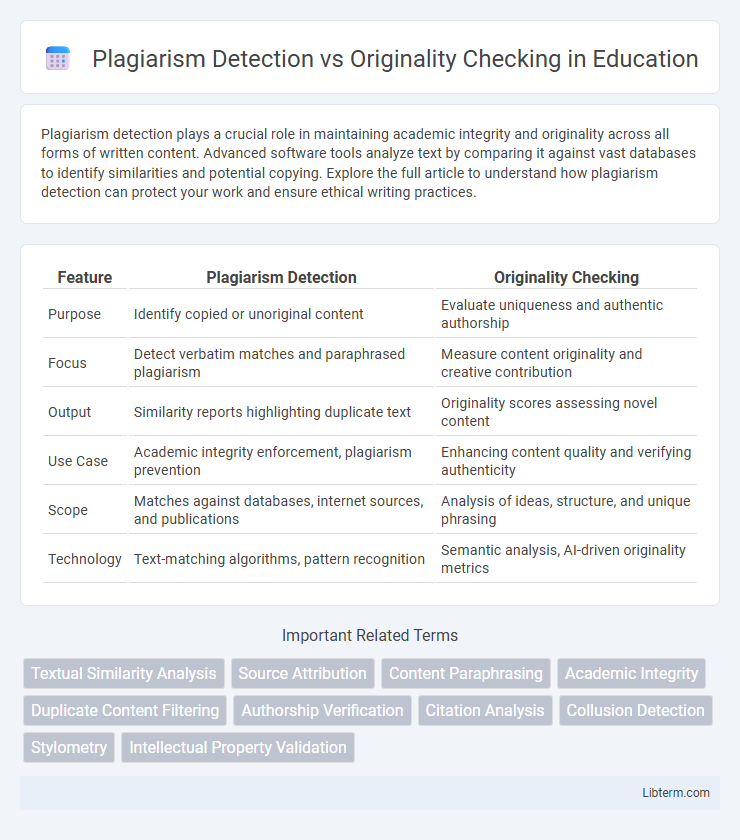Plagiarism detection plays a crucial role in maintaining academic integrity and originality across all forms of written content. Advanced software tools analyze text by comparing it against vast databases to identify similarities and potential copying. Explore the full article to understand how plagiarism detection can protect your work and ensure ethical writing practices.
Table of Comparison
| Feature | Plagiarism Detection | Originality Checking |
|---|---|---|
| Purpose | Identify copied or unoriginal content | Evaluate uniqueness and authentic authorship |
| Focus | Detect verbatim matches and paraphrased plagiarism | Measure content originality and creative contribution |
| Output | Similarity reports highlighting duplicate text | Originality scores assessing novel content |
| Use Case | Academic integrity enforcement, plagiarism prevention | Enhancing content quality and verifying authenticity |
| Scope | Matches against databases, internet sources, and publications | Analysis of ideas, structure, and unique phrasing |
| Technology | Text-matching algorithms, pattern recognition | Semantic analysis, AI-driven originality metrics |
Understanding Plagiarism Detection
Plagiarism detection involves using specialized software to scan texts against extensive databases, identifying copied or uncredited content by matching phrases and sentences. This process helps educators and publishers maintain academic integrity by pinpointing instances of direct copying or improper citation. Understanding plagiarism detection enables users to recognize how algorithms assess similarity scores and flag potential content reuse, differentiating it from genuine originality.
What Is Originality Checking?
Originality checking is a process that evaluates written content to ensure it is unique and free from unintentional plagiarism by comparing the text against extensive databases and online sources. This method highlights similarities and potential matches but focuses primarily on verifying the authenticity of the author's ideas and proper citation rather than just detecting copied content. Originality checking tools are essential in academic, professional, and publishing environments to maintain integrity and uphold ethical writing standards.
Key Differences Between Plagiarism Detection and Originality Checking
Plagiarism detection software analyzes text to identify duplicate or copied content by comparing it with a vast database of sources, highlighting exact matches and potential replication. Originality checking evaluates the uniqueness of a text by assessing paraphrasing, citation accuracy, and the overall novelty of ideas presented. The key difference lies in plagiarism detection's focus on finding unauthorized copying, while originality checking emphasizes the text's creative and intellectual contribution.
How Plagiarism Detection Tools Work
Plagiarism detection tools function by scanning submitted text against extensive databases containing academic papers, websites, and other digital content to identify matching or similar phrases and sentences. These tools utilize algorithms that analyze textual patterns, synonyms, and paraphrasing techniques to detect copied content beyond simple word-for-word matches. By generating similarity reports with highlighted sections, plagiarism detection software helps educators and researchers verify the originality of work and ensure proper citation practices.
Techniques Used in Originality Checking
Originality checking primarily employs advanced techniques such as text fingerprinting, stylometric analysis, and machine learning algorithms to evaluate the uniqueness of submitted content. Stylometric analysis examines writing style features including syntax, vocabulary, and punctuation patterns to detect inconsistencies or copied segments. Machine learning models further enhance accuracy by learning contextual patterns and semantic relationships beyond simple text matching, enabling deeper evaluation of originality.
Common Challenges in Detecting Plagiarism
Plagiarism detection faces common challenges such as distinguishing between coincidental text similarities and intentional copying, managing paraphrased or translated content, and dealing with limited access to proprietary databases and unpublished materials. Originality checking tools often struggle with context understanding, leading to false positives or negatives when evaluating nuanced or domain-specific content. Ensuring accuracy requires continuous updates to detection algorithms and comprehensive source databases to effectively identify subtle or sophisticated forms of plagiarism.
Benefits of Originality Checking for Content Creators
Originality checking offers content creators precise insight into the uniqueness of their work, ensuring protection against unintentional plagiarism and enhancing credibility. It promotes authentic content development by identifying areas that require rephrasing or additional citation, thereby improving overall quality. This process also supports compliance with publishing standards and academic integrity, fostering trust with audiences and institutions.
Top Plagiarism Detection Tools Compared
Top plagiarism detection tools like Turnitin, Grammarly, and Copyscape offer advanced algorithms that scan extensive databases to identify duplicate content and ensure originality. Turnitin excels in academic settings with its vast repository of scholarly works, while Grammarly provides real-time checks for grammar and plagiarism, ideal for writers and professionals. Copyscape is preferred for web content, offering accurate detection of copied material across online sources, making it a top choice for publishers and SEO specialists.
Best Practices for Ensuring Content Originality
Effective plagiarism detection involves using advanced software tools like Turnitin or Copyscape to scan text against extensive databases for duplicate content. Originality checking, on the other hand, emphasizes evaluating the uniqueness of ideas and phrasing while ensuring proper citation of sources. Best practices for ensuring content originality include consistently paraphrasing, crediting all references accurately, and employing both automated detection tools and manual review to maintain academic and professional integrity.
Future Trends in Plagiarism Detection and Originality Checking
Future trends in plagiarism detection and originality checking emphasize leveraging artificial intelligence and machine learning to improve accuracy and contextual understanding of content. Advanced algorithms will enable real-time analysis and cross-referencing with an expanding global database of academic, online, and proprietary sources for deeper semantic analysis. Emerging technologies such as blockchain are poised to enhance transparency and traceability in content creation, fostering greater trust and integrity in originality verification processes.
Plagiarism Detection Infographic

 libterm.com
libterm.com